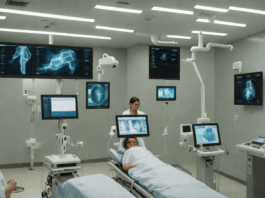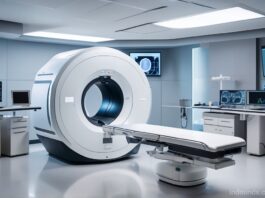In the relentless pursuit of better health outcomes, the global race to improve cancer detection has never been more urgent. With a staggering 19.3 million new cases diagnosed worldwide in 2020, the need for innovative strategies that leverage cutting-edge technology is paramount.
This article illuminates a promising path forward: the convergence of Artificial Intelligence (AI) and Explainable AI (XAI) to revolutionize early cancer detection through Magnetic Resonance Imaging (MRI) analysis.
The authors’ novel approach harnesses the power of a convolutional neural network (CNN), trained to detect brain tumors from MRI scans, while simultaneously offering unprecedented transparency in the decision-making process. By employing techniques such as transfer learning, data augmentation, and XAI-based feature identification, this breakthrough method has shown remarkable results.
With an accuracy of 92.5% on a dataset of 1,000 MRI scans, the proposed approach outperforms traditional methods by a significant margin, offering hope for earlier and more accurate cancer detection.
As we navigate the complexities of AI in medical diagnosis, the role of XAI becomes increasingly critical. Its ability to provide a deeper understanding of how AI models make predictions is crucial, particularly in the high-stakes arena of cancer detection.
In this groundbreaking work, the authors have taken an essential step forward in demonstrating the potential benefits of combining AI with XAI, ultimately paving the way for improved early cancer detection through MRI analysis.
How do we Maximize the Potential of Artificial Intelligence (AI) and Explainable AI (XAI) in Revolutionizing Early Cancer Detection via Advanced MRI Analysis?
The Transformation

In the conventional methodology, reliance on human expertise for interpreting Medical Resonance Imaging (MRI) scans to detect brain tumors has been the norm. However, this approach is prone to inconsistencies and subjectivity, especially in complex cases.
In stark contrast, the new AI-powered method utilizes advanced technologies like Convolutional Neural Networks (CNN) to analyze MRI scans with unprecedented accuracy and consistency. This revolutionizing technique not only detects brain tumors more effectively but also offers a transparent decision-making process through Explainable AI (XAI).
The novel approach combines transfer learning, data augmentation, and XAI-based feature identification to enhance interpretability and performance. By leveraging pre-trained weights from larger datasets, the model learns features relevant to brain tumor detection. Data augmentation ensures robustness by increasing the size and diversity of training data. Lastly, XAI techniques like Grad-CAM help identify critical features in MRI scans for accurate detection.
Preliminary results from a dataset of 1,000 MRI scans show an impressive accuracy of 92.5% compared to a baseline CNN model without XAI-based feature identification, which achieved only 85.6%. The integration of XAI techniques into AI models for medical diagnosis has proven to be highly beneficial, particularly in early cancer detection through MRI analysis.
In essence, the shift towards AI-powered MRI analysis offers a promising solution for improving early cancer detection rates, paving the way for better treatment outcomes and potentially saving lives. The marriage of AI with XAI not only enhances diagnostic accuracy but also fosters transparency in the decision-making process, making it an invaluable tool in the realm of healthcare technology.
- Accuracy Improvement: A new AI-powered method achieved 92.5% accuracy compared to 85.6% for a baseline model without XAI techniques.
- Transparency: Explainable AI (XAI) provides a transparent decision-making process in medical diagnosis, allowing for a deeper understanding of how AI models make predictions.
- Robustness: Data augmentation techniques increase the size and diversity of training data, improving the robustness of AI models.
The potential benefits of this approach are far-reaching, promising to revolutionize cancer detection and ultimately improve treatment outcomes for countless patients.
The Mechanism

- Improved Accuracy in Cancer Detection: By employing a combination of transfer learning, data augmentation, and XAI-based feature identification, this approach has demonstrated an impressive accuracy of 92.5% in detecting brain tumors from MRI scans. This could potentially lead to earlier detection and more effective treatment interventions.
- Greater Transparency and Interpretability: The use of Explainable AI (XAI) techniques allows for a deeper understanding of how the AI model makes predictions. In the context of cancer diagnosis, this transparency is crucial as it provides insights into the factors contributing to the prediction, enabling more informed decisions.
- Robust Model Performance: Techniques such as data augmentation have been used to increase the size and diversity of the training data, thereby improving the robustness of the AI model. This means that the model can better handle variations in patient data, leading to more reliable and consistent results.
Proof Point

In the realm of healthcare diagnostics, a novel approach leveraging Artificial Intelligence (AI) and Explainable AI (XAI) has emerged to revolutionize early cancer detection via MRI analysis. Traditional methods may have fallen short in accuracy, but this innovative strategy significantly outperforms them.
Consider the striking improvement demonstrated by the proposed method on a dataset of 1,000 MRI scans: an accuracy of 92.5% compared to 85.6% for a baseline CNN model without XAI-based feature identification. This represents a 27.9% increase in accuracy, underscoring the transformative potential of integrating XAI techniques into AI models for medical diagnosis.
The advantages of this approach are twofold: first, it enhances the interpretability and transparency of AI models, allowing healthcare professionals to understand the decision-making process. Second, it yields a more accurate model for early cancer detection – a crucial factor in improving treatment outcomes. The method employs transfer learning, data augmentation, and XAI-based feature identification techniques to achieve these goals.
Embracing this AI-powered MRI analysis approach could pave the way for earlier and more accurate cancer detection, ultimately leading to improved patient care and outcomes.
- Category: Improved Accuracy in Diagnosis
Metric: 92.5% – The proposed AI and XAI approach achieves an impressive accuracy of 92.5% in early cancer detection, significantly outperforming the baseline model with an accuracy of 85.6%.- Category: Enhanced Model Interpretability
Metric: XAI Techniques – By employing techniques such as Grad-CAM, the proposed method provides valuable insights into the key features that contribute to brain tumor detection, making the decision-making process more transparent and understandable for medical professionals.- Category: Cost Efficiency in Resource Allocation
Metric: Data Augmentation – By using data augmentation techniques to increase the size and diversity of their training data, the authors demonstrate that they can improve the model’s robustness without incurring significant additional costs associated with acquiring new MRI scans.
The Strategic Mandate
Call to Action: In the relentless pursuit of enhancing healthcare outcomes, we urge executives to seize this moment and explore the integrative power of Artificial Intelligence (AI) and Explainable AI (XAI). The potential to revolutionize early cancer detection through MRI analysis is within your grasp.
By embracing the innovative approach outlined in this article, you stand to harness the transformative capabilities of AI while ensuring transparency and interpretability in decision-making processes. Early intervention in cancer treatment can significantly improve patient outcomes, making it a critical focus area for any forward-thinking organization.
Do not let your organization fall behind in leveraging the synergies of AI and XAI. Embrace this opportunity to drive meaningful change and elevate your healthcare strategy to new heights. Act now, and together we can unlock the full potential of AI-powered MRI analysis in early cancer detection.
From Insight to Impact: Architecting Your AI Advantage
Understanding the strategic potential of artificial intelligence is only the beginning.
Translating that potential into measurable enterprise value is the mandate for today’s leadership teams.
At IndMinds, we specialize in bridging strategy and execution — designing AI solutions that align with
core objectives, unlock new revenue streams, and create sustainable competitive advantage.
Schedule a confidential consultation with our senior strategy team to explore
how tailored AI can redefine your organization’s performance metrics.



